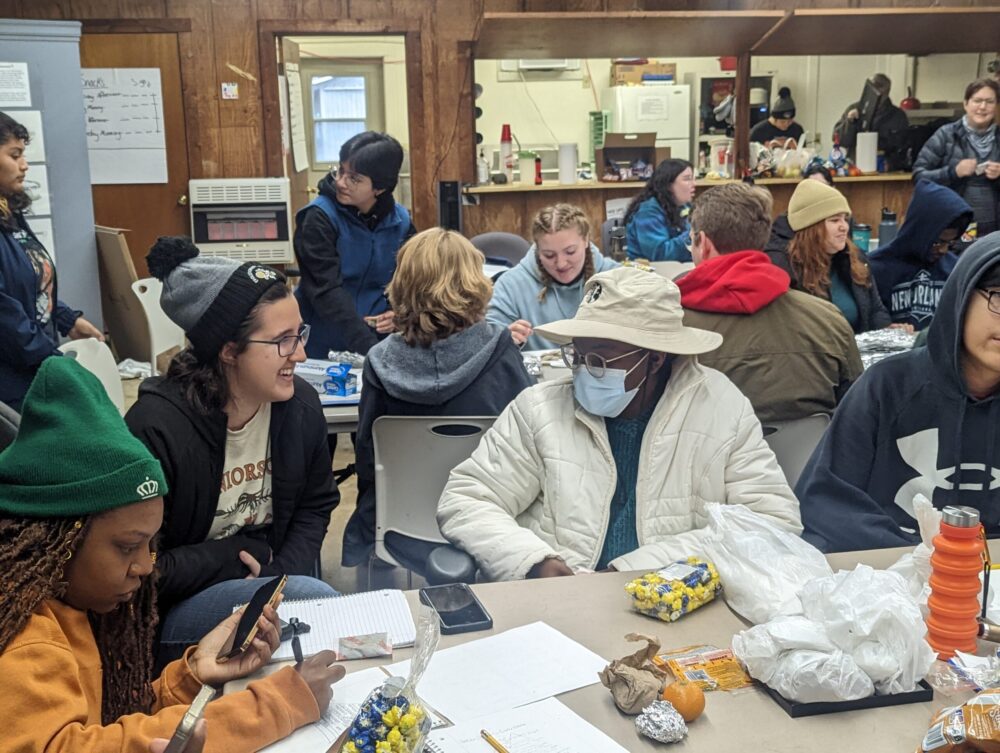Local high schoolers find fossils on ESI-sponsored field trip
By Kelly Tingle, Evolutionary Studies science communications assistant
**This story has been edited to included information about the Collaborative for STEM Education and Outreach
Local students from Stratford and Overton high schools got to excavate 70-million-year-old oysters, clams, and shrimp at the ESI Fossil Search, a field trip sponsored in November by Evolutionary Studies to the Coon Creek Science Center in Adamsville, TN. The fossil search had two main goals: to teach students about food webs and to connect students with Evolutionary Studies Initiative (ESI) grad students, postdocs, and faculty to talk about college, science, and evolution.
Dr. Angela Eeds, the interim director of the Collaborative for STEM Education and Outreach (CSEO), was instrumental in connecting ESI and the high school groups.
According to Eeds, “the student participants from Overton and Stratford are a part of the Interdisciplinary Science and Research program (ISR) that is a collaboration between MNPS and VU, housed under our group’s umbrella – the Collaborative for STEM Education and Outreach.”
The ISR sets up scientists to work directly with teachers. For example, Dr. Kiara Vann, a postdoctoral researcher studying neuroscience and education, pictured below, attended the trip and works closely with teacher Jessica Seifert at Stratford HS.

“The high schoolers and our folks talked about what it means to study evolution in college and the college experience more generally. The students got to meet anthropologists, fungal biologists, and microbiologists,” said ESI Scientific Coordinator Dr. Andy Flick. “Our group had a blast getting to know the students. In the end, it was a great experience for everyone with just an amazing backdrop that is Coon Creek.”
Upon arriving, students were greeted by Dr. Michael Gibson, director of the Coon Creek Science Center, who explained the geological and palaeoecological background of the fossil site. The students were then taken down to the fossil site within the creek bed and taught how to remove specimens from the exposed mud, which Gibson explained was once an ancient seafloor.
Because the animals are so old, excavation can be challenging, and care must be taken.
“There was an initial period of not understanding just how fragile the fossils are. It took some trial and error to be able to remove the fossils correctly, or at least in good pieces,” said Mr. Jaredd Wilson, a biology teacher at Overton HS who accompanied students on the trip.
Once the students got the hang of good techniques, they were keen to keep exploring.
“My students really liked physically digging up the fossils. They really started to get into the mud and hunt for things. They continuously went back to the riverbanks to find more,” said Wilson.
Digging for fossils and discussion with the ESI community helped the high schoolers better understand how science is done.

“I think the scientific thinking process was the idea best demonstrated. ‘Why don’t we see squid fossils? What does it mean that there are so many of the same fossils?’. The fossil search helped students appreciate the ‘mystery solving’ aspect of paleontology,” shared Mr. Wilson.
The field trip came at a great time for Mr. Wilson because the next unit in his class is on Mollusks, the group of animals that include oysters, clams, and gastropods, many of which the students found at the fossil site.
ESI doesn’t currently have any similar trips planned for the future but will continue to work closely with Stratford and Overton high schools going forward.
“The teachers are clearly passionate, the students were great, and our group had a wonderful time,” said Dr. Flick.
“I would easily recommend this to all high school and middle school science classes. It covers so many aspects of different science, geology, ecology, zoology, and paleontology… in my 20 years of teaching, it was probably the best field trip I’ve ever been on,” said Mr. Wilson.
This field trip was supported, in part, by a regional outreach grant from the Society for the Study of Evolution to Dr. Flick.